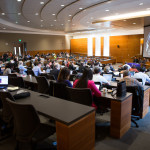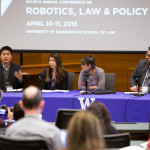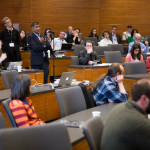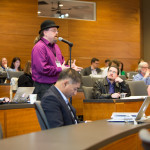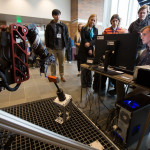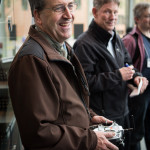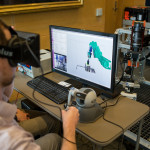Category Archives: Uncategorized
Watch We Robot
Not able to make it to We Robot 2015? Want to watch your favorite panel again? Below are links to all of the talks that made We Robot 2015 great.
WeRobot 2015 Keynote: An Evening with Tony Dyson
Tony Dyson, noted roboticist and special effects model-maker, and the builder of R2D2, discusses the future of robotics with Professor Ryan Calo of the University of Washington School of Law.
Friday, April 10
WeRobot 2015 Panel 1: “Who’s Johnny? (Anthropomorphizing Robots)”
Author: Kate Darling
Discussant: Ken Goldberg
Paper: http://bit.ly/1bxvbfR
As we increasingly create spaces where robotic technology interacts with humans, our tendency to project lifelike qualities onto robots raises questions around use and policy. Based on a human-robot-interaction experiment conducted in our lab, this paper explores the effects of anthropomorphic framing in the introduction of robotic technology. It discusses concerns about anthropomorphism in certain contexts, but argues that there are also cases where encouraging anthropomorphism is desirable. Because people respond to framing, framing could serve as a tool to separate these cases.
WeRobot 2015 Panel 2: “Robot Passports”
Author: Anupam Chander
Discussant: Ann Bartow
Paper: http://bit.ly/1QBX2fp
Can international trade law, which after all seeks to liberalize trade in both goods and services, help stave off attempts to erect border barriers to this new type of trade? The smart objects of the 21st century consist of both goods and information services, and thus are subject to multiple means of government protectionism, but also trade liberalization. This paper is the first effort to locate and analyze the Internet of Things and modern robotics within the international trade framework.
WeRobot 2015 Panel 3: “Robotics Governance”
Peter Asaro of the New School, Jason Millar of Queen’s University, Kristen Thomasen of the University of Ottawa, and David Post of the New America Foundation discuss the challenges facing governance and regulation of emerging robotic technologies.
- Peter Asaro: “Regulating Robots: A Multi-Scale Approach to Developing Robot Policy and Technology” http://bit.ly/1H1fZE8
- Jason Millar, “Sketching an Ethics Evaluation Tool for Robot Design and Governance” http://bit.ly/1Fsqro4
- Kristen Thomasen, “Driving Lessons: Learning from the History of Automobile Regulation to Legislate Better Drones” http://bit.ly/1DQQrnx
WeRobot 2015 Panel 4: “Regulating Healthcare Robots”
Authors: Drew Simshaw, Nicolas Terry, Kris Hauser, M.L. Cumming
Discussant: Cindy Jacobs
Paper: http://bit.ly/1Csn4s0
There are basic, pressing issues that need to be addressed in the nearer future in order to ensure that robots are able to maintain sustainable innovation with the confidence of providers, patients, consumers, and investors. We will only be able to maximize the potential of robots in healthcare through responsible design, deployment, and use, which must include taking into consideration potential issues that could, if overlooked, manifest themselves in ways that harm patients and consumers, diminish the trust of key stakeholders of robots in healthcare, and stifle long-term innovation by resulting in overly restrictive reactionary regulation. In this paper, we focus on the issues of patient and user safety, security, and privacy, and specifically the effect of medical device regulation and data protection laws on robots in healthcare.
WeRobot 2015 Panel 5: “Law and Ethics of Telepresence Robots”
Authors: J. Nathan Matias, Chelsea Barabas, Chris Bavitz, Cecillia Xie, Jack Xu
Discussant: Laurel Riek
Paper: http://bit.ly/1KoSy7n
The deployment of telepresence robots creates enormous possibilities for enhanced long-distance interactions, educational opportunities, and bridging of social and cultural gaps. The use of telepresence robots raises some legal and ethical issues, however. This proposal outlines the development of a law and ethics toolkit directed to those who operate and allow others to operate telepresence robots, describing some of the potential legal ethical issues that arise from their use and offering proposed responses and means of addressing and allocating risk.
Saturday, April 11
WeRobot 2015 Panel 6: “Unfair and Deceptive Robots”
Author: Woodrow Hartzog
Discussant: Ryan Calo
Paper: http://bit.ly/1KoSy7E
What should consumer protection rules for robots look like? The FTC’s grant of authority and existing jurisprudence make it the preferable regulatory agency for protecting consumers who buy and interact with robots. The FTC has proven to be a capable regulator of communications, organizational procedures, and design, which are the three crucial concepts for safe consumer robots. Additionally, the structure and history of the FTC shows that the agency is capable of fostering new technologies as it did with the Internet. The agency defers to industry standards, avoids dramatic regulatory lurches, and cooperates with other agencies. Consumer robotics is an expansive field with great potential. A light but steady response by the FTC will allow the consumer robotics industry to thrive while preserving consumer trust and keeping consumers safe from harm.
WeRobot 2015 Panel 7: “The Presentation of the Machine in Everyday Life”
Authors: Karen Levy & Tim Hwang
Discussant: Evan Selinger
Paper: http://bit.ly/1bMxso7
As policy concerns around intelligent and autonomous systems come to focus increasingly on transparency and usability, the time is ripe for an inquiry into the theater of autonomous systems. When do (and when should) law and policy explicitly regulate the optics of autonomous systems (for instance, requiring electric vehicle engines to “rev” audibly for safety reasons) as opposed to their actual capabilities? What are the benefits and dangers of doing so? What economic and social pressures compel a focus on system theater, and what are the ethical and policy implications of such a focus?
WeRobot 2015 Panel 8: “Operator Signatures for Teleoperated Robots”
Authors: Tamara Bonaci, Aaron Alva, Jeffrey Herron, Ryan Calo, Howard Chizeck
Discussant: Margot Kaminski
Paper: http://bit.ly/1GBw1Wz
This paper discusses legal liability and evidentiary issues that operator signatures could occasion or help to resolve. We first provide a background of teleoperated robotic systems, and introduce the concept of operator signatures. We then discuss some cyber-security risks that may arise during teleoperated procedures, and describe the three main task operator signatures seek to address—identification, authentication, and real-time monitoring. Third, we discuss legal issues that arise for each of these tasks. We discuss what legal problems operator signatures help mitigate. We then focus on liability concerns that may arise when operator signatures are used as a part of a real-time monitoring and alert tool. We consider the various scenarios where actions are conducted on the basis of an operator signature alert. Finally, we provide preliminary guidance on how to balance the need to mitigate cyber-security risks with the desire to enable adoption of teleoperation.
WeRobot 2015 Panel 9: “Robot Economics”
Andra Keay, Garry Mathiason, and Dan Siciliano discuss a variety of economic benefits, consequences, and externalities posed by the widespread integration of robots into 21st century society. Much of the discussion focuses on the potential impact of robots on employment and labor markets.
WeRobot 2015 Panel 10: “Personal Responsibility and Neuroprosthetics”
Authors: Patrick Moore, Timothy Brown, Jeffrey Herron, Margaret Thompson, Tamara Bonaci, Sara Goering, Howard Chizeck
Discussant: Meg Leta Jones
Paper: http://bit.ly/1J4Mtfp
This paper investigates whether giving users volitional control over therapeutic brain implants is ethically and legally permissible. We believe that it is not only permissible—it is in fact advantageous when compared to the alternative of making such systems’ operation entirely automatic. From an ethical perspective, volitional control maintains the integrity of the self by allowing the user to view the technology as restoring, preserving, or enhancing one’s abilities without the fear of losing control over one’s own humanity. This preservation of self- integrity carries into the legal realm, where giving users control of the system keeps responsibility for the consequences of its use in human hands.
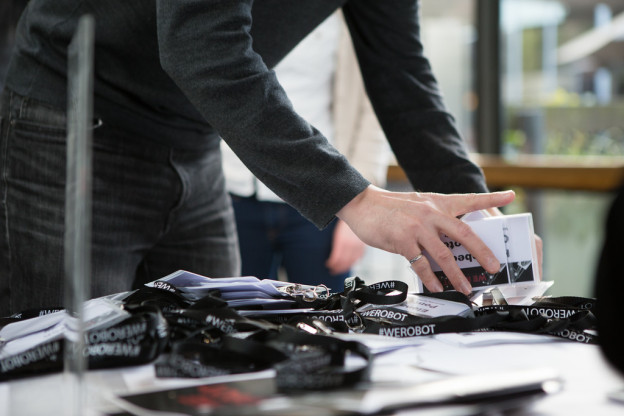
We Robot 2015 in Pictures
We Robot 2015 was a fantastic success, with scholars from around the nation converging on Seattle to share ideas, explore new concepts, and engage in lively discussion about the future of law and robotics.
We Robot 2015 Program
Registration is open for We Robot 2015 and we have a great program planned:
Friday, April 10
8:00 am
Registration
8:40 am
Welcome Remarks: Dean Kellye Testy, University of Washington School of Law
Introductory Remarks: Ryan Calo, Program Committee Chair
9:00 am
Paper: Kate Darling, Who’s Johnny? Anthropomorphic framing in human-robot interaction, integration, and policy
Discussant: Ken Goldberg, UC Berkeley
10:00 am Break
10:15 am
Paper: Anupam Chander, Robot Passports
Discussant: Ann Bartow, Pace Law School
11:15 am Break
11:30 am
Panel: Robotics Governance
- Peter Asaro, Regulating Robots: A Multi-Scale Approach to Developing Robot Policy and Technology
- Jason Millar, Sketching an Ethics Evaluation Tool for Robot Design and Governance
- Kristen Thomasen, Driving Lessons: Learning from the History of Automobile Regulation to Legislate Better Drones
Moderator: David Post, Senior Fellow, Open Technology Institute/New America Foundation
1:00 pm Lunch
2:00 pm
Paper: Drew Simshaw et al., Regulating Healthcare Robots in the Hospital and the Home: Considerations for Maximizing Opportunities and Minimizing Risks
Discussant: Cindy Jacobs, University of Washington
3:00 pm Break
3:15 pm Paper: J. Nathan Matias et al., Legal and Ethical Issues in the Use of Telepresence Robots: Best Practices and Toolkit
Discussant: Laurel Riek, University of Notre Dame
4:15 pm Break
4:30 pm
Demonstrations
5:30 pm
Reception
7:00 pm
Special Guest Lecture
Saturday, April 11
8:00 am
Registration
8:30 am
Paper: Woodrow Hartzog, Unfair and Deceptive Robots
Discussant: Ryan Calo, University of Washington School of Law
9:30 am Break
9:45 am
Paper: Karen Levy & Tim Hwang, The Presentation of Machine in Everyday Life
Discussant: Evan Selinger, Philosophy, Rochester Institute of Technology
10:45 am Break
11:00 am
Paper: Tamara Bonaci et al., I Did It My Way: On Law and Operator Signatures for Teleoperated Robots
Discussant: Margot Kaminski, Moritz College of Law, The Ohio State University
12:00 pm Lunch
1:00 pm
Panel: Robot Economics
- Colin Lewis, Robohub.org
- Andra Keay, Silicon Valley Robotics
- Garry Mathiason, Robotics, Artificial Intelligence (AI) and Automation, Littler Mendelson
Moderator: Dan Siciliano, Stanford School of Law
2:30 pm Break
2:45 pm
Paper: Patrick Moore et al., Personal Responsibility in an Age of User-Controlled Neuroprosthetics
Discussant: Meg Leta Jones, Communication, Culture & Technology, Georgetown University
3:45 pm
Concluding Remarks: Ryan Calo & Michael Froomkin

